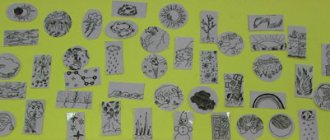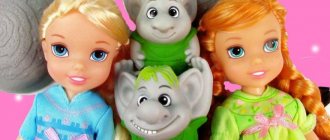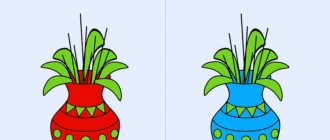MAGAZINE Preschooler.RF
Didactic game “The House We Live In” Author: Zvereva Olesya Borisovna MBDOU kindergarten “Childhood”, combined type kindergarten No. 160, Nizhny Tagil. Designed for independent play of children and joint organization of educational activities of pupils with parents or teachers. Goal: Creating conditions for optimizing the process of sensory development of younger preschoolers by ensuring the accumulation of ideas about the color, shape and size of objects. Progress of the game: Stage 1: v The first floor is green. To get to the game, you need to unfasten the carabiner and zipper. Behind the green doors the child finds the game “Flower of Seven Flowers.” Each petal is fastened with a button. Behind the petals is a pyramid. Every detail of the pyramid is attached with Velcro. Objectives of the 1st stage of the game: 1. Develop tactile sensitivity of the fingers, fine motor skills of the fingers when fastening, unfastening, and applying; 2. Introduce the shape of an object, color, size; sequence of objects; 3. Learn to group by size; 4. Introduce various materials (different types of fabric).Stage 2:
Progress of the game:
v The second floor is red. In order to find a game, “We are going, going, going...” The child needs to unfasten two hooks and unlace the sashes. A truck opens in front of the child, in the back of which lie tactile geometric shapes. The cabin door closes with a hook, and behind the transparent window the child can place his or her photo or a picture of the driver. Traffic lights on linden trees. Sun on the button.
Objectives of stage 2 of the game:
1. Develop tactile sensitivity of the fingers, fine motor skills of the fingers when fastening, unfastening, and applying;
2. Introduce the shape of an object, color, size; sequence of objects;
3. Promote memorization of geometric shapes;
4. Develop imagination.
Stage 3:
Progress of the game:
v The third floor is blue. Fastened with a buckle, two buttons of different sizes and a button. Behind the doors is the game “Draw a Path.” The child uses a cord to connect rings of the same color with a picture related to this character.
Objectives of the 3rd stage of the game:
1. Develop tactile sensitivity of the fingers, fine motor skills of the fingers when fastening, unfastening, threading;
2. Develop logic and imagination.
Result: children develop fine motor skills of their fingers, and their fingers become more sensitive. Children know the shape of objects, color, size, sequence of objects, and know how to group objects. They know geometric shapes. They gain self-service skills (they know how to button and unfasten buttons, buttons, zippers). Logic and imagination become more developed.
| Next > |
Didactic material on the topic “Our home, our city, our country”
Assignment: Read a story to your child, answer questions with him, and then play games.
“There are a lot of countries on Earth. Our country is Russia. This is our Motherland, the place where you were born, where you live with your parents and friends.
Each country has a flag, anthem and coat of arms. Our Russian flag has three stripes. White means purity and justice. Blue is a peaceful sky. Red - strength and beauty. This flag was introduced into Russia by Tsar Peter the Great. When the national anthem is played and the national flag is raised, the citizens of this country stand.
Each country also has its own coat of arms. The coat of arms of Russia is a double-headed eagle.
Our Motherland is huge, it has a lot of cities, villages, rivers, lakes, seas. The most important city in the country is called the capital. The capital of Russia is the city of Moscow. You live in a city, town or village, and this place is necessarily marked on the map.
But besides this, each person has his own home. People all over the world live in a wide variety of homes. They build them from various materials. Some houses are built of brick or stone, others of wood, clay or reeds.”
Ask your child questions:
— What is the name of our country? Name the capital of our Motherland. — What color is the flag of our country? — Who introduced this flag into Russia? — What is the name of your hometown or village? - Give me your home address. — What material can people build their house from?
1. Complete the sentence.
My country is called ... (Russia) The capital of our country is ... (Moscow city) My city (village) is called - ... My home address is ...
2. Choose as many words as possible to match the adult’s word.
Country (which?) -... (huge, beloved, beautiful, only, rich, powerful, endless) City (which?) -... (big, small, clean, green, well-groomed, dear, etc.)
3. Who lives in their native land? Circle the plants and animals that can be found in your area.
4. There is always a lot of traffic on the streets of our cities and therefore you need to be careful. Look at the pictures and tell which child is behaving incorrectly. Highlight them.
5. A red car drives to a house with a blue garage. Travel with the car: tell it what it will go past, where it will turn, where it will stop and why before it reaches the garage.
6. Name the parts of the room and the house.
Door, window, ceiling, floor, walls.
Balcony, stairs, roof, walls, windows, doors. (House)
7. Help each hero find his home. (Draw the lines). Think like this: “Carlson lives on the roof,” etc.
8. Name the rooms in the house.
Living room, bedroom, hallway, bathroom, children's room, kitchen, utility room (storage room), dining room.
9. Choose as many words as possible that will tell you what we do in different rooms of the house (apartment).
In the living room (what are they doing?) – watching TV, relaxing, receiving guests. In the bedroom (what are they doing?) - they sleep, rest, In the hallway (what are they doing?) - they dress, undress, take off their shoes, put on their shoes, greet, see off (guests). In the bathroom (what are they doing?) - they wash, shower, take a shower, bathe, brush their teeth, comb their hair, etc. In the nursery (what are they doing?) - they play, teach, study, sleep, relax, etc. In the kitchen (what are they doing?) - they cook, boil, fry, cut, wash (dishes), eat, etc. In the dining room (what are they doing?) - they have breakfast, lunch, dinner.
10. Tell us what houses are like.
The house has many floors - it is... (multi-storey) The house has one floor - it is... (single-storey) The house has many apartments - it is... (multi-apartment) The house has one entrance - it is... (single entrance) The house has many entrances - it is (multi-entrance) House built of brick - it is ... (brick) Made of wood - ... (wooden) Of blocks - ... (block)
11. Who do you think the artist forgot to draw in the empty window? Finish it.
12. Think and tell where Pinocchio is standing, using the words at, for, because of, between, right, left.
Pinocchio is standing behind the house. To the right of Buratino is a one-story house. To the left of Buratino is a multi-storey building. Buratino stands between a multi-story and a one-story building. Pinocchio is standing near the house. Pinocchio looks out from behind the house.
13. The tallest clown lives in a house, to the right of which a birch tree grows, the shortest one lives in a house, behind which a Christmas tree grows. Draw lines from the clowns to their houses.
14. Compose the story “Home Alone” from the pictures and write it down. Don't forget to put it in your story book.
Sample story:
“Vanya and his faithful friend Tuzik love to play together. But Vanya goes to school and cannot play with Tuzik all the time. Before leaving for school, Vanya strictly ordered Tuzik not to be naughty and to behave exemplarily. But after the boy left, Tuzik became bored and forgot about what Vanya was punishing him. He grabbed the tablecloth in his teeth and began to rush around the house with it. When the boy returns from school, he will have to put his house in order for a long time.”
Teacher-speech therapist Gomzyak Oksana Stepanovna
- Summary of a speech therapy lesson on the topic “Our Country”
- Summary of the educational activity “We love our city very much”
- Summary of logorhythmic lesson [Country Mylyandiya]
- Scenario for speech therapy leisure “Journey to the City of Beautiful Speech”
- Summary of a lesson on teaching older preschoolers literacy “Journey to the city of Zvukograd”
( 7 liked, average score: 5.00 out of 5)
Loading...





